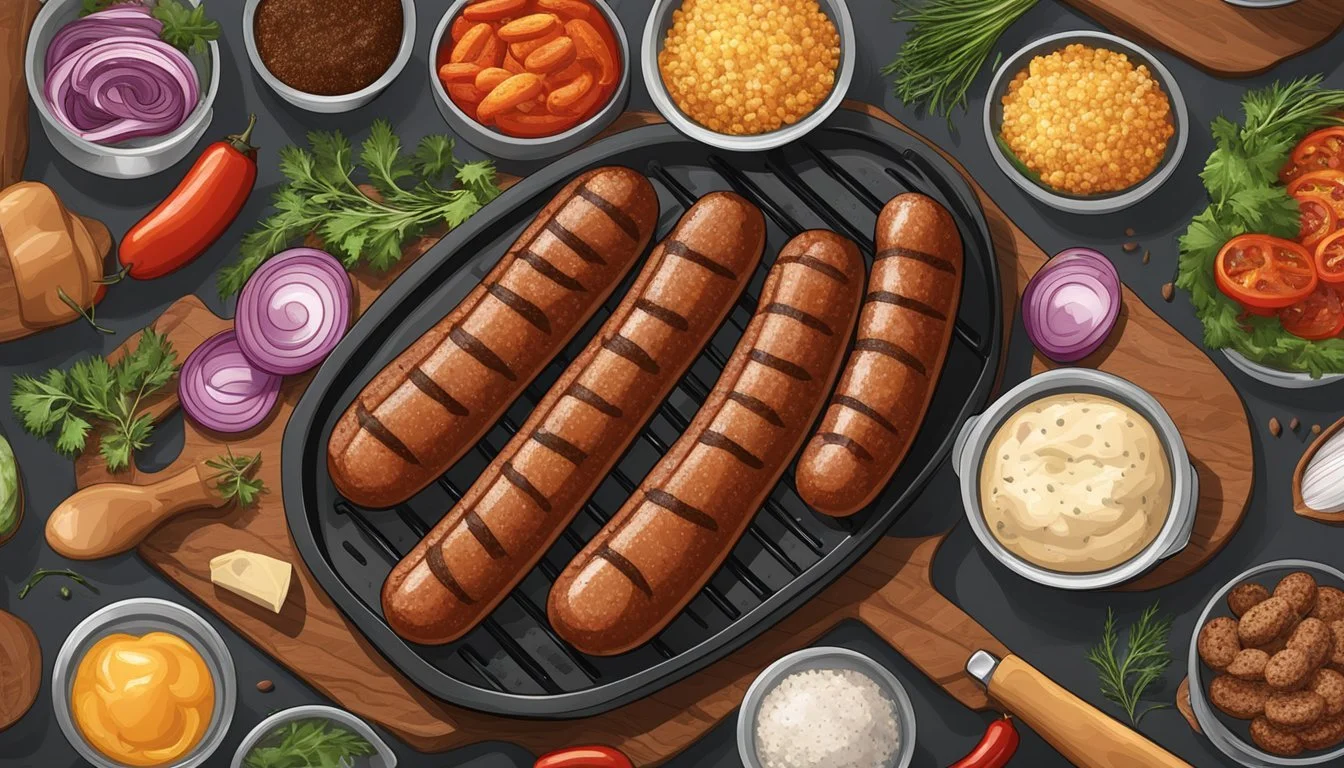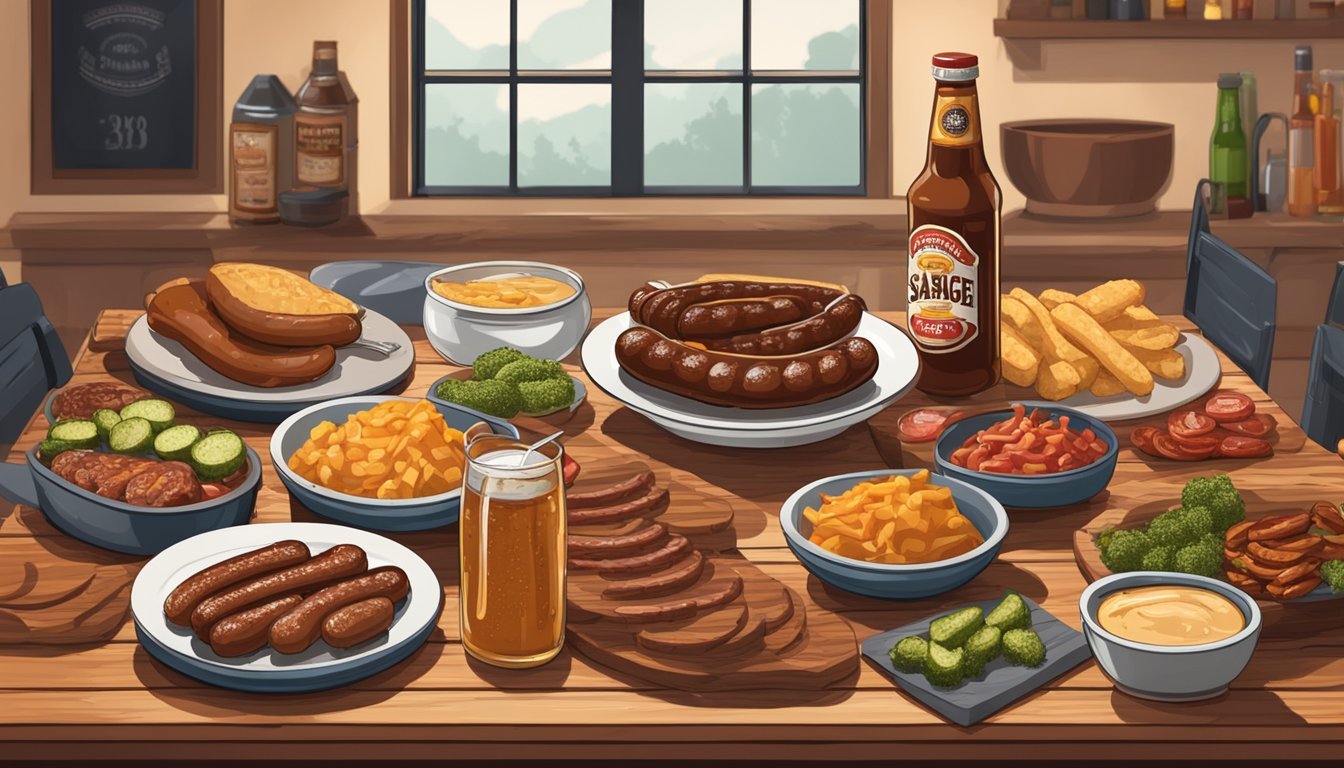Texas Sausage BBQ Guide
Tips for Perfect Smoked Flavor
Texas barbecue (What wine goes well with barbecue?) culture reveres its trinity of smoked meats — brisket, ribs, and sausage. While brisket generally garners the limelight with its melt-in-your-mouth smokiness and ribs impress with their tender, fall-off-the-bone appeal, sausage holds a special spot in the heart of the Lone Star State's barbecue history. The variety on offer ranges from fresh to smoked sausages, including specialties like the hot link—a spicy beef (how long does beef last?) sausage with a flavor kick from cayenne and sometimes even ghost peppers. Authentic Texas sausages derive much of their character from the meat ratio, combining brisket trimmings or ground beef with pork for a balanced taste, and the granulated or fresh garlic that earns some garlicky types the nickname "garlic bombs."
Central Texas, an epicenter of BBQ culture, boasts a deep-rooted tradition of Czech and Polish sausages, subtly flaunting the influence of European immigrants on the local cuisine. These sausages are typically made with coarsely ground meat stuffed into natural hog or pork casings, ensuring a delightful snap with every bite. Seasonings play a crucial role with generous amounts of black pepper, kosher salt, (how long does kosher salt last?) and garlic powder (how long does garlic powder last?) coming together to create the iconic, robust flavor profiles.
The process of making Texas sausage is an art in itself, often involving a sausage stuffer to encase the finely ground or coarsely chopped meat mixed with brisket fat and spices. As they slow-smoke over oak or hickory, the sausages absorb a distinctive smoky flavor. Sausages in Texas BBQ are rarely a mere side dish; they're integral to the gastronomic experience—a testament to the state's diverse food culture and history, and a must-try for any barbecue aficionado visiting places like Austin, Fort Worth, or East Texas, where the smoke from BBQ pits is a welcoming beacon to deliciousness.
Historical Roots of Texas Sausage BBQ
Texas sausage BBQ is a tradition deeply rooted in the heritage of German and Czech immigrants, who brought their meat processing techniques and flavors to Central Texas, leading to the evolution of a unique barbecue staple.
German and Czech Influences
German and Czech settlers brought their sausage-making practices to Texas in the 19th century. They introduced a variety of sausages, including types that have become central to Texas barbecue such as coarsely ground beef sausages, spicy Polish sausages, and Czech sausages known for their delicious flavors. These immigrants utilized natural hog casings and a blend of meats, most commonly pork and beef, seasoned with kosher salt, black pepper, and garlic, to create a product that was not only tasty but also shelf-stable in the Texas heat. Towns like Elgin, often referred to as the "Sausage Capital of Texas," became known for their butcher shops and meat markets.
Central Texas smokehouses often used smoked sausage recipes that involved a meat ratio optimized for taste and preservation. These traditional techniques were adapted over time to incorporate a wide variety of ingredients, like cayenne pepper for heat and garlic powder for additional flavor, leading to a diverse range of sausages including the fiery hot link and more finely ground options.
Texas Sausage Evolution
Over the years, the process of making sausages in Texas evolved due to the influences of local tastes and available ingredients. Barbecue joints in areas like Austin, Fort Worth, and East Texas placed an emphasis on fresh sausage, made daily, and smoked sausage, a product that allowed them to use every part of the animal. Brisket trimmings and fat became common in the grind, contributing to the smoky flavor that has become synonymous with Texas BBQ.
As demand for these sausages grew, the need for efficiency led to the development of tools like the sausage stuffer, streamlining the production of both fresh and smoked sausages. Simultaneously, the variety of sausages expanded, ranging from the spicy sausage, seasoned with ghost peppers, to garlic bombs using fresh garlic instead of granulated garlic. Natural casings remained the standard for quality, giving the sausages their characteristic snap when bitten into.
Changes in technology and taste have led to a wide variety of sausage types now featured in Texas barbecue, from ground beef and pork ribs (What wine goes well with pork ribs?) to exotic meats. Nonetheless, the core elements of Central Texas sausage making – the use of natural ingredients, the melding of meat with savory spices, and the traditional smoking process – continue to define this iconic element of Texas barbecue.
Key Ingredients and Seasonings
The crafting of authentic Texas BBQ sausage relies heavily on choice cuts of meat and a harmonious blend of traditional spices. These foundations create the distinctive flavor profile that Texas sausage is celebrated for.
Meat Selection
In Texas BBQ, beef and pork are often the meats of choice. Traditional recipes call for a balanced meat ratio that ensures a rich, moist sausage. Brisket trimmings, known for their ideal fat-to-lean ratio, are a popular beef option, particularly in Central Texas. Fresh sausage made daily is a common sight in local meat markets, where natural hog casings or natural casings are stuffed with this freshly ground meat.
Signature Spices
A quintessential Texas BBQ sausage isn't complete without its core seasonings:
Salt and Pepper: Kosher salt and coarsely ground black pepper form the base of most rubs, essential for moisture retention and adding heat.
Garlic: Whether using fresh garlic, granulated garlic, or garlic powder, this ingredient adds a critical layer of flavor. Some aficionados prefer a hint of garlic, creating what's lovingly referred to as "garlic bombs" in the mix.
Paprika: Offers a smoky flavor and vibrant color.
Cayenne Pepper: A pinch can elevate the heat, creating a spicy sausage known as a "hot link."
Additional spices like cumin or even ghost peppers, are used for extra heat and complexity in certain recipes. Together, these spices are carefully measured and mixed to season the ground meat before it's funneled into casings with a sausage stuffer. Whether it's a Polish sausage, Czech sausage, or a local hot dish variation, the consistent attention to quality ingredients and preparation methods is what defines delicious Texas BBQ sausage.
Smoking Techniques and Equipment
Mastering the smoking process and selecting the right equipment are fundamental for crafting authentic Texas sausage BBQ. From traditional smokers that have been used for generations to the latest grilling methods, there is a range of techniques capable of producing the rich, smoky flavors synonymous with Texas cuisine.
Traditional Smokers
Traditional smokers utilized in Central Texas are typically offset smokers, where the firebox is set aside from the main cooking chamber, allowing for indirect heat smoking. The key components in traditional smoking are:
Temperature Control: Maintaining a consistent temperature, usually between 225°F and 250°F, is crucial for even smoking.
Wood Selection: Hardwoods like oak, hickory, or mesquite impart distinct smoky flavors.
Airflow Management: Regulating the smoker's vents to ensure proper airflow aids in temperature control and smoke distribution.
In traditional practices, a mix of beef brisket (What wine goes well with beef brisket?) trimmings, with a suitable meat-to-fat ratio, is commonly used for making sausages such as the hot link—a spicy sausage loved by many. Natural casings, preferably natural hog casings, are favored for encasing the coarsely ground meat, seasoned with black pepper, kosher salt, and often cayenne pepper or ghost peppers for heat. Czech sausages and Polish sausages are also popular, encompassing a wide variety of flavors and textures from finely to coarsely ground formulations.
Modern Grilling Practices
Modern grilling practices have introduced a versatile approach to smoking sausages. Equipment and tools often seen are:
Pellet Smokers: Easy temperature control and consistent smoke production, suitable for both beginners and professionals.
Gas or Electric Smokers: These offer convenience for those in urban settings or with less space.
Smoking Boxes or Tubes: Added to standard grills to create a smoky environment.
Modern techniques also involve shorter smoking times at higher temperatures, such as 250°F, which can be ideal for fresh sausages (how long do fresh sausages last?). In places like Austin, Texas, and Fort Worth, enthusiasts might employ a fusion of methods, blending old-school techniques with modern conveniences, such as using a sausage stuffer to streamline the process. Seasonings have also expanded to include a range of flavors, from garlic powder and granulated garlic to "garlic bombs" with chunks of fresh garlic to cater to a variety of palates desiring a delicious sausage experience.
Iconic Texas Sausage BBQ Joints
Texas is home to a rich tradition of sausage making, stemming from its diverse cultural heritage. The state prides itself on featuring a variety of sausage BBQ joints, from time-honored markets to modern restaurants that bring the flavors of Central Texas and beyond to the forefront.
Famous Barbecue Markets
Kreuz Market, in Central Texas, is renowned for its smoked sausage crafted with a combination of beef and pork. Their sausages are encased in natural hog casings and seasoned primarily with black pepper and salt, honoring a family recipe that dates back over a century.
City Market in Luling and Smitty's Market in Lockhart are also pillars of Texas sausage history. Both markets provide a selection of classic Texas barbecue, with a focus on coarsely ground sausages. They utilize a blend of spices and smoke to create a distinctive, robust flavor profile, including options like spicy sausage and their well-loved jalapeño variety.
Contemporary BBQ Restaurants
In Austin, Louie Mueller Barbecue has gained acclaim for its sausage offerings, like the beef and pork hot links that deliver a bold taste accented with a peppery kick. They balance meat ratio and seasoning to perfection, resulting in a rich smoky flavor that has been perfected since their opening in 1949.
Interstellar BBQ in Austin takes a creative approach, often experimenting with brisket trimmings and a mix of spices, which may include cayenne pepper for heat, and garlic powder for a savory note. Their sausage recipes exhibit a dedication to the craft, featuring finely ground meat stuffed into natural casings, then smoked to achieve an out-of-this-world taste profile.
These BBQ joints maintain the longstanding tradition of Texas sausage barbecue while pushing the boundaries to entice meat lovers with a penchant for quality and flavor.
Serving and Pairing Suggestions
When serving Texas BBQ sausage, attention to detail with sides, condiments, and beverages can elevate the meal. A combination of traditional accompaniments and proper drink pairings can enhance the flavors of the smoked or fresh sausage, whether it's a beef sausage from a Central Texas meat market or a spicy hot link from East Texas.
Traditional Sides and Condiments
Sides:
Coleslaw: A classic side with a crunch, often dressed with vinegar or mayo.
Potato Salad: Best served cold, with ingredients like mustard (how long does mustard last?) and pickles.
Beans: Pinto beans (how long does pinto beans last?) cooked slowly with onions and spices are a hearty option.
Texas Toast: Thick slices of buttered and grilled bread for mopping up sauce.
Condiments:
BBQ Sauce: A variety of thickness and flavors from sweet to tangy complements sausage's smokiness.
Hot Sauce (how long does hot sauce last?): Offers a spicy kick, often enhancing the piquancy of hot links or spicy sausages.
Mustard: A traditional dollop of mustard works well with milder sausages, like polish or Czech varieties.
Pickles & Onions: Slices of pickle and raw onion act as a palate cleanser between bites.
Beverage Accompaniments
Beers:
Lagers: Light and refreshing, they can cut through the richness of fatty brisket trimmings in sausage.
Ales: Heavier ales pair well with boldly flavored, spicy sausages; the maltiness can stand up to the heat.
Wines:
Zinfandel: A robust red wine that can complement the smoky and spicy notes of BBQ sausage.
Riesling: A sweeter white wine offering a contrast to the savory notes of the sausage.
Non-Alcoholic:
Iced Tea: Sweetened or unsweetened, this classic Texas refreshment is a go-to for all BBQ dishes.
Lemonade: The sweetness and tartness can provide a refreshing balance to a salty and smoky sausage plate.






